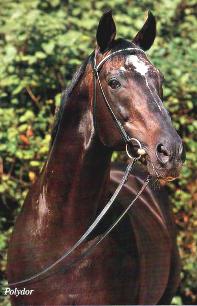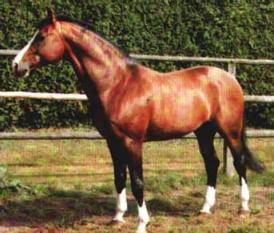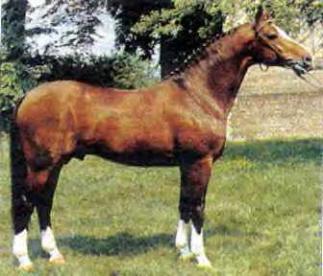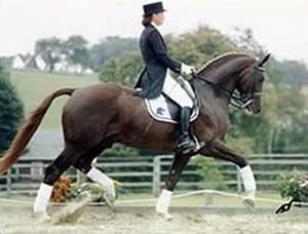Pilot was the youngest showjumper millionaire that has ever existed among Germany's stallions. He was a brand name
for the transmission of showjumping ability, far beyond the borders of Westphalia from the outset. When Wolfang
Brinkmann won team gold on the Pilot son Pedro at the Seoul Olympics in 1988, Pilot had just turned 14 and was at
the apex of his career. Unfortunately however, he was not in good health at that point in time already, so that he was
no longer stationed outside of his home covering station any longer, but remained at the Warendorf covering station.
At the same time, his showjumping progeny continued their triumphal processions around the globe: Pirol / Lesley Mc
Naught, P.S. Priamos / Ludger Beerbaum resp. Dirk Hafemeister, Prinzregent 7 / Norbert Koof and numerous others.
Many Pilot progeny had the reputation, not undeservedly, of being professional horses. Even if the FN breeding value
for dressage indicates something else, it is generally known that Pilot progeny did not necessarily favour the demands
of dressage sport. Pilot represents the "second" Westphalian P-line. If one assumes the "first P-line" to be that of
Papayer xx (via Paradox I and II), then Pilot's genealogical path leads back via Pilatus and Perseus to the
thoroughbred Pluchino xx, who covered at the Werthmann stud (Soest-Lhringen) from 1958 to 1975 as a private
stallion. Pilatus who was likewise a private stallion in Westphalia produced a second masterpiece, Polydor. On his
damside Pilot's pedigree includes the first rate sire Graphit. The grandam Kornelia, a daughter of the last original
Trakehner Keith, foaled prime products from diverse sires. Mated with Duden II, she produced the showjumper
Darling Boy, who with breakneck speed tallied numerous successes with Wolfgang Behne and with the top Trakehner
sire Mahagoni, produced the stallion Macon, who initially covered at the Eichgrund stud for a short while, before going
to Sweden. Pilot only attained the age of 17 and in comparatively few years, managed to move mountains so to speak.
Many sons were tested, some reacted well, others not at all. Pro Pilot II, Power Game, Pilot's Highlight and Palazzo
were infertile and several others had fecundity problems. As his health condition increasingly worsened, Pilot was put
down at the beginning of 1991. High class deep frozen sperm was harvested throughout his life, during his royal stud
period, which is partly still utilised today. Even while he was alive, Pilot sired approved sons by this method, including
sons like Polling in Bavaria. In 1998 two Pilot progeny were candidates at the Westphalian foal auction.
for the transmission of showjumping ability, far beyond the borders of Westphalia from the outset. When Wolfang
Brinkmann won team gold on the Pilot son Pedro at the Seoul Olympics in 1988, Pilot had just turned 14 and was at
the apex of his career. Unfortunately however, he was not in good health at that point in time already, so that he was
no longer stationed outside of his home covering station any longer, but remained at the Warendorf covering station.
At the same time, his showjumping progeny continued their triumphal processions around the globe: Pirol / Lesley Mc
Naught, P.S. Priamos / Ludger Beerbaum resp. Dirk Hafemeister, Prinzregent 7 / Norbert Koof and numerous others.
Many Pilot progeny had the reputation, not undeservedly, of being professional horses. Even if the FN breeding value
for dressage indicates something else, it is generally known that Pilot progeny did not necessarily favour the demands
of dressage sport. Pilot represents the "second" Westphalian P-line. If one assumes the "first P-line" to be that of
Papayer xx (via Paradox I and II), then Pilot's genealogical path leads back via Pilatus and Perseus to the
thoroughbred Pluchino xx, who covered at the Werthmann stud (Soest-Lhringen) from 1958 to 1975 as a private
stallion. Pilatus who was likewise a private stallion in Westphalia produced a second masterpiece, Polydor. On his
damside Pilot's pedigree includes the first rate sire Graphit. The grandam Kornelia, a daughter of the last original
Trakehner Keith, foaled prime products from diverse sires. Mated with Duden II, she produced the showjumper
Darling Boy, who with breakneck speed tallied numerous successes with Wolfgang Behne and with the top Trakehner
sire Mahagoni, produced the stallion Macon, who initially covered at the Eichgrund stud for a short while, before going
to Sweden. Pilot only attained the age of 17 and in comparatively few years, managed to move mountains so to speak.
Many sons were tested, some reacted well, others not at all. Pro Pilot II, Power Game, Pilot's Highlight and Palazzo
were infertile and several others had fecundity problems. As his health condition increasingly worsened, Pilot was put
down at the beginning of 1991. High class deep frozen sperm was harvested throughout his life, during his royal stud
period, which is partly still utilised today. Even while he was alive, Pilot sired approved sons by this method, including
sons like Polling in Bavaria. In 1998 two Pilot progeny were candidates at the Westphalian foal auction.
PILATUS
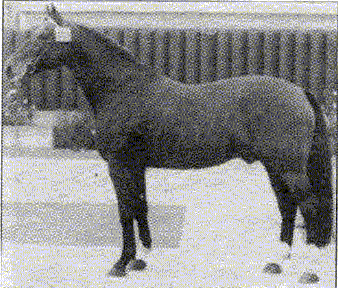
Pilatus, Westphalian (Generation 3)
PILATUS sired 14 sons and 13 state premium mares. Here are
some: Perlkönig I (P - Lavendel), Perlkönig II (P - Lavendel), Pianist
(P - Ern), Picasso (P - Obermaat xx), Pikör (P - Rendant), Pilot (P -
Graphit), Piräus (P - Rendant), Pisano (P - Raimond), Planet (P -
Günstling) Polarstern (P - Frülicht I) Polydor (P - Frülicht I) who sired
Paganini "V", Platini, Polidiktus van de Helle, Polipektus and Poor
Boy, Pontius (P - Grande), Princ Glamour (P - Gold Dollar) and
Roemer (P - Cyrano) sire of Darwin, grandsire of Inspekteur.
The history of Perlkonig goes back to the late 50's when the then
director of the Westfalien state stud, Dr Gerd Lehmann imported four
Irish Thoroughbreds: Sinus, Papayer and Pluchino. Pluchino was an
Ascot Stakes winner in the UK. In his first season, Pluchino
produced two licensed sons, Perseus out of a mare by that influential
anglo/arab sire of jumping horses, Ramzes, and Plutos out of a mare
by the famed Hanoverian, Duellant.
Perseus in his first season was bred to another daughter of Duellant,
to produce, Pilatus. Pilatus was second in the licensing of 1967, and
stood for ten seasons in Germany before he was exported to Holland,
where he stood another five seasons. Pilatus returned to Westfalia in
1984, but not before he sired, Roemer (out of a Westfalien mare by
Cryano) who has proven an influential dressage sire in both Holland
and the United States, and Darwin, out of a mare by Pion. Pilatus
was the sire of two of the most influent stallions of modern times,
Polydor and Pilot.
some: Perlkönig I (P - Lavendel), Perlkönig II (P - Lavendel), Pianist
(P - Ern), Picasso (P - Obermaat xx), Pikör (P - Rendant), Pilot (P -
Graphit), Piräus (P - Rendant), Pisano (P - Raimond), Planet (P -
Günstling) Polarstern (P - Frülicht I) Polydor (P - Frülicht I) who sired
Paganini "V", Platini, Polidiktus van de Helle, Polipektus and Poor
Boy, Pontius (P - Grande), Princ Glamour (P - Gold Dollar) and
Roemer (P - Cyrano) sire of Darwin, grandsire of Inspekteur.
The history of Perlkonig goes back to the late 50's when the then
director of the Westfalien state stud, Dr Gerd Lehmann imported four
Irish Thoroughbreds: Sinus, Papayer and Pluchino. Pluchino was an
Ascot Stakes winner in the UK. In his first season, Pluchino
produced two licensed sons, Perseus out of a mare by that influential
anglo/arab sire of jumping horses, Ramzes, and Plutos out of a mare
by the famed Hanoverian, Duellant.
Perseus in his first season was bred to another daughter of Duellant,
to produce, Pilatus. Pilatus was second in the licensing of 1967, and
stood for ten seasons in Germany before he was exported to Holland,
where he stood another five seasons. Pilatus returned to Westfalia in
1984, but not before he sired, Roemer (out of a Westfalien mare by
Cryano) who has proven an influential dressage sire in both Holland
and the United States, and Darwin, out of a mare by Pion. Pilatus
was the sire of two of the most influent stallions of modern times,
Polydor and Pilot.
Roemer by Pilatus
Polydor
Pilot
The chestnut stallion Papayer xx covered as a private stallion in Westphalian breeding for ten
years, from 1961 to 1972. His achievements were quite out of the ordinary. His first year at stud
already produced the top international competition mare Panama 4 / Peter Schmitz (i.a. winner
of the French Showjumping Derby in La Baule). She was the dam of the first rate full-siblings
Gaylord 6 / Hendrik Snoek resp. Golden Gate / Lutz Merkel (both by Goldberg). His second
crop resulted in the bay Privatier, one of the most successful dressage horses of his generation.
Papayer xx's third covering season gave rise to the legendary sire Paradox I, who together with
his six year younger full-brother Paradox II was destined to disseminate the valuable genotype of
his sire. Schwangau, who was a half-brother of these two brothers, was a maker of showjumpers
who also acquired breeding significance. The maternal dynasty is based on the lineage mare Harfe
(by Hartwig-Heerführer-Omar III-Liborius), which produced not only the sons of Arnika, but
also the dark tan Adler (by Adlerruf-Astrachan-Schwank; private stallion Westphalia). Paradox I
first occupied a loose box at the state stud of Ostenfelde. His star however only began to shine
when he was restationed at Neuenkirchen, where he was increasingly mated with Dolorit
daughters. This was a resounding success. Padrona 2 / Hans Heinrich Quellen, Prinzeß /
Gunnar Schlosser, Palma Nova / Rainer Supan resp. Hendrick Snoek, Parbleu / Heinrich
Wilhelm Jahannsmann, Payot / Woflgang Brinkmann, Summertime / Dietrich Schulze, Paloma /
Franke Sloothaak and numerous more established his fame as a procreator of world rank
showjumpers. As a rule, his progeny were wiry, prominent, dry chestnuts, often with a hot
temperament and frequently with hard to restrain drive. The younger Paradox II, who as a private
stallion and the successor of his sire Papayer xx covered at the Sandhove station in Ascheberg
was not in the limelight as much as his older brother, although he too, was very convincing both in
sport and breeding. As good as Paradox I was, he did not manage to sire a son that was his
equal. Of the large number of approved sons, not one was fully able to take his place in every
respect. Great expectations were placed in Pascal, Pakt and Palisander. The black stallion
Parcours performed better than all three put together and Parademarsch I and II appear to be the
ones most likely to be on a par with Paradox I. Paradox I was oftentimes utilised as an upgrader,
a task which he fulfilled well. The products that resulted however also necessitated an injection of
fresh blood in order to receive the desired type, something that did not always eventuate. In 1994
a monument was erected in Paradox I's honour on the grounds of the North Rhine Westphalian
state stud of Warendorf. Paradox I personally attended the unveiling, before his death in 1995.
years, from 1961 to 1972. His achievements were quite out of the ordinary. His first year at stud
already produced the top international competition mare Panama 4 / Peter Schmitz (i.a. winner
of the French Showjumping Derby in La Baule). She was the dam of the first rate full-siblings
Gaylord 6 / Hendrik Snoek resp. Golden Gate / Lutz Merkel (both by Goldberg). His second
crop resulted in the bay Privatier, one of the most successful dressage horses of his generation.
Papayer xx's third covering season gave rise to the legendary sire Paradox I, who together with
his six year younger full-brother Paradox II was destined to disseminate the valuable genotype of
his sire. Schwangau, who was a half-brother of these two brothers, was a maker of showjumpers
who also acquired breeding significance. The maternal dynasty is based on the lineage mare Harfe
(by Hartwig-Heerführer-Omar III-Liborius), which produced not only the sons of Arnika, but
also the dark tan Adler (by Adlerruf-Astrachan-Schwank; private stallion Westphalia). Paradox I
first occupied a loose box at the state stud of Ostenfelde. His star however only began to shine
when he was restationed at Neuenkirchen, where he was increasingly mated with Dolorit
daughters. This was a resounding success. Padrona 2 / Hans Heinrich Quellen, Prinzeß /
Gunnar Schlosser, Palma Nova / Rainer Supan resp. Hendrick Snoek, Parbleu / Heinrich
Wilhelm Jahannsmann, Payot / Woflgang Brinkmann, Summertime / Dietrich Schulze, Paloma /
Franke Sloothaak and numerous more established his fame as a procreator of world rank
showjumpers. As a rule, his progeny were wiry, prominent, dry chestnuts, often with a hot
temperament and frequently with hard to restrain drive. The younger Paradox II, who as a private
stallion and the successor of his sire Papayer xx covered at the Sandhove station in Ascheberg
was not in the limelight as much as his older brother, although he too, was very convincing both in
sport and breeding. As good as Paradox I was, he did not manage to sire a son that was his
equal. Of the large number of approved sons, not one was fully able to take his place in every
respect. Great expectations were placed in Pascal, Pakt and Palisander. The black stallion
Parcours performed better than all three put together and Parademarsch I and II appear to be the
ones most likely to be on a par with Paradox I. Paradox I was oftentimes utilised as an upgrader,
a task which he fulfilled well. The products that resulted however also necessitated an injection of
fresh blood in order to receive the desired type, something that did not always eventuate. In 1994
a monument was erected in Paradox I's honour on the grounds of the North Rhine Westphalian
state stud of Warendorf. Paradox I personally attended the unveiling, before his death in 1995.
